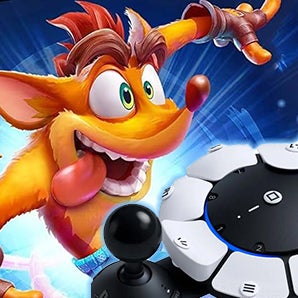Last year, PlayStation launched their own iteration of an accessible controller. The Access Controller is a circular device that allows full software customization for each input, as well as multiple button caps and control sticks. It’s a good piece of hardware that encapsulates the individualistic nature of the disabled experience. While it’s not perfect for my needs, its existence is crucial for disabled inclusion in gaming.
Adaptive equipment is a necessity for many disabled individuals. And as companies like Xbox and PlayStation begin to restrict third-party controllers and hubs, the reliance on first-party alternatives is more pressing than ever. For this installment of Access Designed, several disabled players discuss the adaptive controllers they use, why they are beneficial, and their hopes for the future of accessible hardware.
Choosing an Accessible Controller
Accessible devices actively dismantle inaccessible barriers when playing games. Switches, buttons, and even homemade modifications provide levels of access that game options and designs cannot achieve. When paired with accessible innovations like extensive menus and inclusive gameplay, disabled individuals have the capability to play games previously unavailable to them.
Lucas Miller heavily relies on adaptive controllers to perform actions within games. After a stroke in his late 30s affected his left hand and arm, he struggles to use standard controllers. Without the capability to utilize his left hand, he relies on using his mouth, right hand, and feet. However, if a game features numerous buttons, the likelihood of him completing it drastically drops.
“Depending on the platform, I use the [Xbox Adaptive Controller] with input switches from Warfighter Engaged,” Miller said. “For PlayStation, I recently purchased the Access Controller. But for everyday use, I have a PlayStation and Xbox one-handed controller from Evil Controllers. They are my workhorses, as I’m able to hold it in my right hand and reach the buttons as well as move my character with my foot.”
Despite owning both first-party accessible hardware options, Miller notes the Access Controller is more accommodating for his needs than the other. With the XAC, disabled individuals can fully customize the switches or buttons they use, how each input is read on the game, and the exact position of each button or switch. Yet, despite the overall flexibility of the control hub, the more switches, sticks, and buttons players use, the more space is needed. And without the use of his left hand and arm, Miller requires compact setups to properly play.
“The XAC, even with the Logitech Accessibility Gaming Kit, I feel it’s too spread out and could be easier to set up,” he said. ”Don’t misunderstand me; I’m thankful for what I have and can play games again, but it’s too big in my opinion. I’d love to see an official Xbox movement stick added to their XAC, as well as the costs associated to be more competitive. Lastly, I’d like to see more compact options. To ease up space on my tabletop or hand.”
Unfortunately for many disabled individuals like Miller, accessible hardware can be quite costly, especially “as a father of three on disability benefits.” For the XAC, each input can be relatively expensive, with the Logitech Adaptive Gaming Kit costing $99.99, as well as the varying costs for buttons, switches, and sticks through third-party vendors. Disabled players need to consistently account for factors like overall budget and gaming space before deciding on an appropriate device. Yet, Miller acknowledges that without these devices, he would not be able to properly play or enjoy most games. Despite the bevy of accessibility options and designs, accessible hardware is crucial for physically disabled players.
Beneficial Devices
Even with barriers like cost and space, disabled individuals like Miller will always need and use adaptive hardware. While some players use them alongside standard controllers, others solely rely on them to make games accessible. From low-actuation force buttons and switches to customizable software, adaptive equipment significantly diminishes the energy required to play games.
Danielle Maycox’s hands are unable to grasp standard controllers. With spinal muscular atrophy, her muscles progressively weaken over time, leaving her unable to execute precise inputs, especially with her left hand. Currently, she cannot press L3, R3, or the triggers on a DualSense. For her, the Access Controller enables her to finally use the PlayStation 5.
“The Access Controller has meant that I could build my own custom setup straight out of the box using the various buttons and sticks,” Maycox said. “The software that comes with the Access controller has been particularly good for me. The ability to set profiles for different games generally means that I can leave the physical setup as it is and then just tweak the profile and button assignments as needed. In comparison to a standard PlayStation controller, the Access controller opens options that I just didn’t have before and [means] that for the first time I can play on my PS5 without having to use remote play.”
Maycox’s capability to play is a direct result of the innovative software within the Access Controller. Customizing inputs, as well as establishing multiple profiles for different games, is crucial to conserve physical and mental energy during extensive play sessions. As an avid trophy hunter, she notes that she is finally able to resume collecting platinum trophies, especially for intensive platformers like Crash 4.
“With my previous setup, I was able to earn the platinum trophies for the N’Sane trilogy, but Crash 4 was just one button more than what I could manage,” she said. “In Crash 4 many of the levels use a mask ability which requires a quick press of [the] triangle to activate the mask, but when going for the time trials I just couldn’t do that extra button-press quickly enough. But now that I’ve been able to build my own setup and tweak button assignments, that Crash 4 platinum is in sight.”
Maycox and Miller aren’t the only disabled players reliant on appropriate shapes and sizes for accessible hardware. Liana Ruppert originally preferred PC gaming due to the customizability of mouse and keyboard. With multiple sclerosis, Ruppert’s hands sometimes lack the capability to appropriately respond to events in game. Since the release of first-party adaptive hardware, she can once again enjoy console gaming.
“Generally, the shape of current accessibility controllers is super-beneficial because I can clearly see the topography of the overall layout,” Ruppert said. “Pair that with being able to customize the inputs to what works best for my playstyle depending on the game, and that's been a massive help during massive flareups. Especially so because playing games is a part of my job; there are limited windows of availability, tight deadlines. It's nice having tools like these to keep the flow going.”
Customization is key, especially for the disabled experience in gaming. Being able to choose the button size, placement, and functionality is important for individuals with limited reach, as well as those with progressive disabilities. With standard controllers, every button and stick is in fixed positions, coupled with less-than-ergonomic designs for physically disabled individuals. This is the primary reason why people like Ruppert need these devices.
“The freedom,” she said when asked why such devices are important. “The ability to use the Xbox Adaptive Controller with custom switches and joysticks. The accessories alone are enough to really play into that ... way of playing so that whatever accommodation needs [are] being met, it doesn't negatively impact how you as the player experience the game.”
The Future of Adaptive Hardware
Currently, only two first-party devices are on the market. While they can be paired with varying accessories from vendors, disabled players don’t have a wide array of choices. And as studios like Xbox and PlayStation continue to prohibit the use of third-party controllers, disabled individuals may struggle to find suitable alternatives if the XAC and Access Controller fail to suit their needs. As Ruppert suggests, continuous innovation and market competition are essential for new pieces of inaccessible hardware. Despite the competition from creating these controllers and hubs, disabled players will ultimately benefit from companies trying to outdo one another.
“I hope that more companies throw in on the competition,” Ruppert said. “More competition on the market means a potential increase in innovation and availability. I want to see accessible-forward accessories get the same treatment as standard peripherals get: Gimme the cool colors, the limited-edition models, the game-inspired accessibility controllers. We want to have fun and express ourselves too. If we can get the innovation for features and the inclusion in fun consumer experiences, I think that would be a really great thing to see for an entire market of gamers that is used to feeling ignored.”
Yet, aside from standard capitalistic tendencies and market competition, innovation is necessary for the dynamic nature of being disabled. While some disabilities are relatively static in nature, those with progressive illnesses like Maycox and Ruppert’s rely on a consistent evolution of hardware. This is especially pertinent with the individualistic nature of being disabled. The Access Controller, for example, is not a perfect device even though Maycox can once again enjoy series like Crash Bandicoot.
“I hope that in the future there will be many accessibility options with customizable controllers available to suit different disabilities as I don’t think one controller can ever meet the needs of everyone,” Maycox said. “I also hope that they remain accessible in terms of price. It would be great to see the Access Controller available as a bundle so that people who are purchasing a PS5 don’t then need to make a separate purchase for the Access Controller. If that’s the controller you need, it would be great for it to come with the PS5 just like the DualSense already does.”
Accessible hardware is just as important as menus with dozens of options. Without these devices, disabled players would be unable to access some of the most accessible games. Further, it provides disabled players with a level of independence previously unavailable with standard controllers. While not perfect, as the first-party accessible hardware market is in its relative infancy, disabled players finally have a choice between which system they can play. As the industry continues to innovate, hopefully they will develop more hardware solutions for an array of disabilities. And as Ruppert notes, disabled players are no longer stuck with one option.
“I don't have to pray to the gaming gods for more console exclusives [to] eventually make their way over to PC. I can enjoy them when everyone else can regardless of flare-ups.”
Grant Stoner is a disabled journalist covering accessibility and the disabled perspective in video games. When not writing, he is usually screaming about Pokémon or his cat, Goomba on Twitter.





